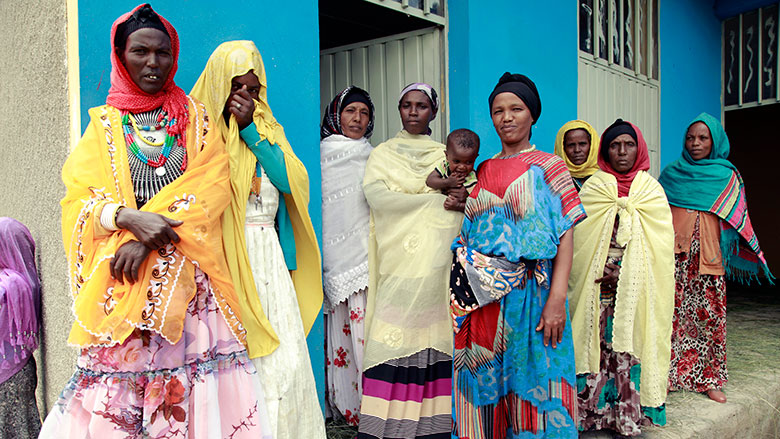Challenge
Over the past decade, Ethiopia has achieved high economic growth, averaging 10.7% per year, establishing the country among the fastest growing economies both in Africa and the developing world. However, Ethiopia is falling behind its peers in the area of credit to the private sector. At the same time, opportunities for women entrepreneurs in Ethiopia lag far behind those of men. In The Economist’s Women’s Economic Opportunity index, Ethiopia occupies the 107th rank out of 112 countries. Most growth-oriented women entrepreneurs fall into a ‘missing middle’ trap, in which they are served neither by commercial banks nor by microfinance institutions. High minimum loan sizes and excessive collateral requirements restrict women’s access to loans from commercial banks. Microfinance Institutions (MFIs) primarily cater to micro-firms with group lending schemes that provide very small loans. Growth-oriented women-owned enterprises are therefore starved of the investment they need to thrive.
Approach
The Women Entrepreneurship Development Project (WEDP) provides finance and business support for growth-oriented women entrepreneurs in Ethiopia. WEDP created the first ever women-entrepreneur focused line of credit in Africa in 2013. After fully disbursing its IDA commitment in two years, the project was expanded through co-financing from Japan, Italy, Canada, and the European Investment Bank. The WEDP line of credit is currently disbursing roughly $3 Million in loans and training roughly 600 entrepreneurs every month. The project is implemented by the Development Bank of Ethiopia (DBE) and the Federal Agency for Urban Job Creation (FUJCFSA) and is currently working 12 participating microfinance institutions and a network of training providers across the country.
Results
- One of the only women-focused line of credit operations in the world, WEDP has been recognized for its innovative and effective model of reaching women entrepreneurs. Lessons from the WEDP Ethiopia model are informing initiatives to finance women entrepreneurs in other countries, including Nigeria, Zimbabwe, Madagascar, Turkey, Mexico, and Indonesia.
- As of March 2019, more than 12,000 women entrepreneurs took loans and over 16,000 participated in business training.
- 66% of WEDP borrowers were first-time borrowers had never taken a loan before. Repayment of loans stands at 99.1%.
- WEDP has helped MFIs upscale to reach women entrepreneurs in the missing middle with larger, individual loans. The average WEDP loan size is $12,000 USD, an increase of 870% from the average loan size previously accessed by WEDP clients.
- Impact evaluation data shows that, over 3 years, firms that participate in WEDP have grown incomes by 40.77% relative to a control group, (compared to a 5-year target of 50%) and grown employment in their firms by 55.73% (compared to a 5-year target of 30%)
- By improving loan appraisal techniques, the project helped the country’s leading financial institutions reduce collateral requirements from an average of 200% of the value of a loan (2013) to 125% (2018).
- At the same time, WEDP microfinance institutions are adopting and diffusing new techniques to reach and serve women entrepreneurs better. They are developing new loan products and recognizing new forms of collateral such as vehicles, personal guarantees, and even business inventory, to secure loans. This is all the more relevant in a country where there is no existing collateral registry.
- WEDP is introducing innovative credit technologies to lenders, such as psychometric tests and data-driven credit scoring technologies which can predict the ability of a borrower to repay a loan and reduce the need for collateral. Scaling-up this technology could have a sea-level change on access to credit in Ethiopia.
Bank Group Contribution
WEDP is an IDA $50 million investment lending operation, with an additional $13 million of external funding provided by UK ($3 Million external grant funding) and Canada ($10 Million grant via Trust Fund). The project has been disbursing almost its entire IDA allocation by mid-term and has now secured an additional EUR 15 mill from Italy and Japan has committed $50 million.
Partners
The World Bank team has been able to establish a strong partnership with donors such as the Department for International Development (DFID) and the Canadian International Development Agency (CIDA). Italy and Japan are also about to join the partnership. A WEDP Implementation Committee (WIC) was created to improve collaboration. The WIC is composed of one representative for each of WEDP’s eight implementers (i.e. World Bank, two implementing agencies, donors and consulting firms). The WIC meets monthly to discuss and take decisions on implementation related issues and it represents a very important platform for effective collaboration.
Moving Forward
WEDP is building the basis for establishing a sustainable women entrepreneurs’ financing mechanism and for building the capacity of financial intermediaries and providers of business development services to serve that specific market segment. Although not completed yet, the project has already been effective in paving the way for a larger effort from the Government of Ethiopia in supporting the Small and Medium Enterprises (SME) finance agenda and in demonstrating the existence of a viable model of liquidity + TA that is now been replicated on a much larger scale for the whole SME sector.
Beneficiaries
Serkalem Belay owns an industrial machinery workshop. In Serkalem’s workshop, old vehicle parts are refurbished for re-sale.
Serkalem applied for a WEDP loan for 700,000 Birr from Wasasa, one of the WEDP microfinance institutions (MFIs). Serkalem had applied for business loans in the past, but had never been able to obtain a loan size that met the needs of her growing business.
Serkalem used the loan from Wasasa to purchase additional workshop materials and to hire new employees. In the three months, Serkalem’s workshop has grown from six to twelve full-time employees, and her monthly profits have increased by 50%.
Last Updated: Jun 10, 2019
